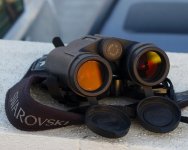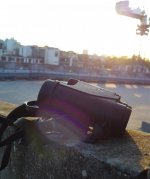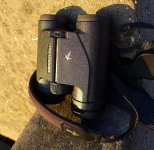I often wonder how black crow is doing, and if he's still reading the thread he started. He'd have liked to have seen what we saw on this day, I'm sure...
----------------
6 August.
Trying a few different spots around a big North London reservoir complex, hoping to get better views of the hobbies (Eurasian hobby, Falco subbuteo) we had seen fairly consistently, but all too briefly, on previous trips.
The first couple of hours are fairly unproductive - a couple of peregrines (one with a full crop) on the pylons which flap off after a while, vanish down into the trees and cannot be found again despite much searching, and a lone sparrowhawk soaring high, moving eastwards. There aren't many martins or swifts around, despite the cloudy conditions that we'd hoped would keep them low and visible. Altogether not all that promising...
At about 1.50pm, about twenty minutes after the cloud had begun to clear, we get our first sighting of the target species - a distant hobby some way to the south which, after a little observation, becomes two. Unfortunately the second bird gets blocked by a large tree and the first eventually dwindles away into the distance. Back we go to the original reservoir, hoping that at least one of the birds would still be spottable...
Just before 1430 my brother spots the distinctive shape of a hobby - thin-winged, elegant, and as compelling to the eye as its flight is effortless - out to the southwest, coming closer. The wind, already light when we started, has dropped off, but even so it gains height in just a few easy circles, needing not even a single wingbeat. For a while it stays high over the reservoir, circling leisurely. Then it picks up the pace, crossing the reservoir in a few seconds, and comes down at a far greater speed, in that classic, dramatic, closed-winged stooping shape. It's almost certainly trying to surprise one of the martins near the old mill by the stream, but we don't see the outcome of the hunt as it disappears down into the trees. Not long afterwards it reappears, clearly having been unsuccessful, regains height in that same effortless manner, and begins catching insects high in the air not far from us.
At about 1450, after a few minutes of keeping a loose group of martins on their toes (keeping above and a little upwind), a second bird suddenly comes stooping past the one we're following. We quickly split the birds while trying to figure out what is happening. The newcomer, which had seemed smaller as it whizzed past the first bird, eventually shows itself to be a little larger - the female. They begin pair-flying, and after a few high-speed circles and stoops, launch into a dramatic series of shallow ups and downs, rapid flickering wingbeats propelling both birds at dazzling speed as they head northwards. The female keeps heading northwards and disappears into the distance.
The male has stayed over the reservoir and both of us now follow him as he heads south, turns westwards, begins flying faster, and then closes his wings and descends in a 45-degree angled stoop that carries him on for what seems an incredible distance. His target, spotted only in the final moment before he attempts the grab, is a martin, which somehow manages to dodge not only the initial attack but also the second attempt a moment later as the hobby, with agility that defies belief, pulls up into a steep, tight upward loop and comes down again, only to miss. He chases the martin downwards and both birds disappear into ground clutter. Time now: 1502.
He's up again - empty-handed once again. Amazed though I am that a bird with such impressive powers of flight has been unsuccessful, I'm glad that more brilliant flying is likely on the cards. He's climbing now, rapidly gaining the height he needs for speed and surprise, his manner of flight light yet powerful, a pleasure to watch. Back across the reservoir he goes, peeling down into another spectacular stoop, this time at a near-vertical angle, streaking down into the trees just to the right of the old mill. Moments later up he comes, flying hard. I think there are three or four hirundines near him that seem larger than the martins we have been seeing, probably swifts. He forces the one he's after to turn and stoops down after it below the treetops, but is again unsuccessful as he soon circles up over the same area. Once again he goes soaring high, moving south, then turning northwards. He's flying hard now, and my brother, with better eyes and a slight advantage in magnification, can see he's after a small target, but he soon quits the pursuit. At extreme distance he comes together with another distant bird of prey, probably a buzzard, pings it a few times, and finally blinks out far into the distance at 1508.
1526. He reappears to the southwest. For the next fifteen minutes or so he's soaring high. The area he's over isn't all that far from us but he's so high that he is a tiny shape, that I can just about see has wings and a tiny tail, against the high white clouds. He doesn't do much other than capture the occasional insect until a second bird, the female, appears again. No acrobatics this time, or at least not until the male heads southward and stoops after another raptor which it chases around for a while. All of a sudden the female comes stooping in - but her target is not the other raptor, but the male, which she proceeds to stoop at/chase around for a bit before both the pair focus their attention on the other raptor and drive it away to the south. It was so far away neither of us could make a 100% ID - most likely a wandering juvenile peregrine, but could possibly have been another female hobby. All three fade out into the distance. It's now about 1545.
1607. Hobby pops up to the east, coming up and down, eating insects. A gull attempts to hassle him, but he slips away on every attempt - not trying to outdistance his pursuer as I've seen other raptors do, but somehow turning away at just the right angle and at the right moment that the distance between them just opens up. Some hirundines (mainly swifts) are now passing through my field of view every now and then, but he keeps capturing and eating insects as he flies high.
1631. after a long period of circling extremely high he heads south and begins a tremendous near-vertical stoop. I hold my breath and concentrate as he goes plummeting down through the heavens for hundreds and hundreds of feet. Even though he's not coming down at full speed, the sheer distance he has fallen is awe-inspiring. He pulls up, changes direction abruptly, and stoops down again, this time much more quickly, after a martin. Down they go into the treetops. He pops up, still after his prey, and I see a couple more attempts but he soon drops down below the treetops and disappears. Lots of martins in that area now.
The reserve is soon to close, so we start heading for home. At around 1645, on our final scan, my brother finds probably the same hobby out to the west, a good way out. He keeps flying high, a distant silhouette in the afternoon sky, until it's time for us to go.
A superb day. Summer raptor watching at its best.
-------------------------
Needing a binocular I could free-hand easily, I took the 8x42 FL black with me that day. I've used it alongside/against, and compared it with my brother's 8.5x42 Fieldpro on many occasions - 8x against 8.5x, nylon versus metal, open bridge versus standard, Abbe-Koening versus Schmidt-Pechan. It did the job I needed it to do really well - light enough to free-hand (including long spells pointing nearly vertically up and tracking targets from 7-800 to 3,000+ feet high), friendly to the eye thanks to the 5mm exit pupil, and able to follow very distant birds further than my old 10x40. The best of what we saw that day is only (regretfully) accessible in my mental hard drive, but I ought to have snapped a shot of both binoculars on the reservoir bank as a memento.







